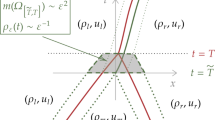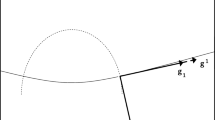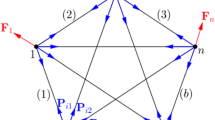Abstract
In modeling and numerically implementing a follower pressure in a geometrically nonlinear setting, one needs to compute the volume enclosed by a surface and its variation. For closed surfaces, the volume can be expressed as a surface integral invoking the divergence theorem. For periodic systems, widely used in computational physics and materials science, the enclosed volume calculation and its variation is more delicate and has not been examined before. Here, we develop simple expressions involving integrals on the surface, on its boundary lines, and point contributions. We consider two specific situations, a periodic tubular surface and a doubly periodic surface enclosing a volume with a nearby planar substrate, which are useful to model systems such as pressurized carbon nanotubes, supported lipid bilayers or graphene. We provide a set of numerical examples, which show that the familiar surface integral term alone leads to an incorrect volume evaluation and spurious forces at the periodic boundaries.







Similar content being viewed by others
References
Taylor N, Gan AB (1986) Submarine pipeline buckling imperfection studies. Thin Walled Struct 4(4):295–323
Ahmetoglu M, Altan T (2000) Tube hydroforming: state-of-the-art and future trends. J Mater Process Technol 98(1):25–33
Feng F, Klug WS (2006) Finite element modeling of lipid bilayer membranes. J Comput Phys 220(1):394–408
Boddeti NG, Liu X, Long R, Xiao J, Bunch JS, Dunn ML (2013) Graphene blisters with switchable shapes controlled by pressure and adhesion. Nano Lett 13(12):6216–6221
Schweizerhof K, Ramm E (1984) Displacement dependent pressure loads in nonlinear finite element analyses. Comput Struct 18(6):1099–1114
Belytschko T, Liu W, Moran B (2001) Nonlinear finite elements for continua and structures. John Wiley & Sons, England
Rumpel T, Schweizerhof K (2003) Volume-dependent pressure loading and its influence on the stability of structures. Int J Numer Methods Eng 56:211–238
Geers M, Kouznetsova V, Brekelmans W (2010) Multi-scale computational homogenization: trends and challenges. J Comput Appl Math 234(7):2175–2182
Bertoldi K, Reis PM, Willshaw S, Mullin T (2010) Negative poisson’s ratio behavior induced by an elastic instability. Adv Mater 22(3):361–366
Overvelde J, Shan S, Bertoldi K (2012) Compaction through buckling in 2d periodic, soft and porous structures: effect of pore shape. Adv Mater 24(17):2337–2342
Shima H, Ghosh S, Arroyo M, Iiboshi K, Sato M (2012) Thin-shell theory based analysis of radially pressurized multiwall carbon nanotubes. Comput Mater Sci 52(1):90–94
Zou J, Huang X, Arroyo M, Zhang S (2009) Effective coarse-grained simulations of super-thick multi-walled carbon nanotubes under torsion. J Appl Phys 105(3):033516
Zhang K, Arroyo M (2013) Adhesion and friction control localized folding in supported graphene. J Appl Phys 113(19):193,501
Zhang K, Arroyo M (2014) Understanding and strain-engineering wrinkle networks in supported graphene through simulations. J Mech Phys Solids 72:61–74
Koenig SP, Boddeti NG, Dunn ML, Bunch JS (2011) Ultrastrong adhesion of graphene membranes. Nat Nanotechnol 6:543–546
Levy N, Burke SA, Meaker KL, Panlasigui M, Zettl A, Guinea F, Neto AHC, Crommie MF (2010) Strain-induced pseudo-magnetic fields greater than 300 tesla in graphene nanobubbles. Science 329(5991):544–547. doi:10.1126/science.1191700
Pan W, Xiao J, Zhu J, Yu C, Zhang G, Ni Z, Watanabe K, Taniguchi T, Shi Y, Wang X (2012) Biaxial compressive strain engineering in graphene/boron nitride heterostructures. Sci Rep 2:893
Staykova M, Arroyo M, Rahimi M, Stone HA (2013) Confined bilayers passively regulate shape and stress. Phys Rev Lett 110:028,101
Campelo F, Allain JM, Amar MB (2007) Periodic lipidic membrane tubes. Europhys Lett 77(3):38,006
Cirak F, Ortiz M, Schröder P (2000) Subdivision surfaces: a new paradigm for thin-shell finite-element analysis. Int J Numer Methods Eng 47(12):2039–2072
Arroyo M, Belytschko T (2004) Finite element methods for the non-linear mechanics of crystalline sheets and nanotubes. Int J Numer Methods Eng 59(3):419–456
Aleksandrov V (1989) Sabitov’s conjecture that volume is stationary under infinitesimal bending of a surface. Sib Math J 30(5):678–684
Deserno M (2004) Notes on differential geometry. Dover, New York. http://www.cmu.edu/biolphys/deserno/pdf/diff_geom.pdf
Li X, Cai W, An J, Kim S, Nah J, Yang D, Piner R, Velamakanni A, Jung I, Tutuc E, Banerjee SK, Colombo L, Ruoff RS (2009) Large-area synthesis of high-quality and uniform graphene films on copper foils. Science 324(5932):1312–1314
Robertson AW, Bachmatiuk A, Wu YA, Schäffel F, Büchner B, Rümmeli MH, Warner JH (2011) Structural distortions in few-layer graphene creases. ACS Nano 5(12):9984–9991
Acknowledgments
European Research Council (FP7/20072013)/ ERC Grant Agreement no. 240487.
Author information
Authors and Affiliations
Corresponding author
Additional information
Mohammad Rahimi and Kuan Zhang have contributed equally to this work.
Rights and permissions
About this article
Cite this article
Rahimi, M., Zhang, K. & Arroyo, M. Computing the volume enclosed by a periodic surface and its variation to model a follower pressure. Comput Mech 55, 519–525 (2015). https://doi.org/10.1007/s00466-014-1119-9
Received:
Accepted:
Published:
Issue Date:
DOI: https://doi.org/10.1007/s00466-014-1119-9




